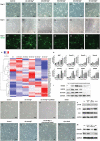Magnesium-Encapsulated Injectable Hydrogel and 3D-Engineered Polycaprolactone Conduit Facilitate Peripheral Nerve Regeneration
- PMID: 35652188
- PMCID: PMC9313484
- DOI: 10.1002/advs.202202102
Magnesium-Encapsulated Injectable Hydrogel and 3D-Engineered Polycaprolactone Conduit Facilitate Peripheral Nerve Regeneration
Abstract
Peripheral nerve injury is a challenging orthopedic condition that can be treated by autograft transplantation, a gold standard treatment in the current clinical setting. Nevertheless, limited availability of autografts and potential morbidities in donors hampers its widespread application. Bioactive scaffold-based tissue engineering is a promising strategy to promote nerve regeneration. Additionally, magnesium (Mg) ions enhance nerve regeneration; however, an effectively controlled delivery vehicle is necessary to optimize their in vivo therapeutic effects. Herein, a bisphosphonate-based injectable hydrogel exhibiting sustained Mg2+ delivery for peripheral nerve regeneration is developed. It is observed that Mg2+ promoted neurite outgrowth in a concentration-dependent manner by activating the PI3K/Akt signaling pathway and Sema5b. Moreover, implantation of polycaprolactone (PCL) conduits filled with Mg2+ -releasing hydrogel in 10 mm nerve defects in rats significantly enhanced axon regeneration and remyelination at 12 weeks post-operation compared to the controls (blank conduits or conduits filled with Mg2+ -absent hydrogel). Functional recovery analysis reveals enhanced reinnervation in the animals treated with the Mg2+ -releasing hydrogel compared to that in the control groups. In summary, the Mg2+ -releasing hydrogel combined with the 3D-engineered PCL conduit promotes peripheral nerve regeneration and functional recovery. Thus, a new strategy to facilitate the repair of challenging peripheral nerve injuries is proposed.
Keywords: hydrogel; magnesium; peripheral nerve regeneration.
© 2022 The Authors. Advanced Science published by Wiley-VCH GmbH.
Conflict of interest statement
The authors declare no conflict of interest.
Figures









Similar articles
-
Nanofibrous nerve guidance conduits decorated with decellularized matrix hydrogel facilitate peripheral nerve injury repair.Theranostics. 2021 Jan 1;11(6):2917-2931. doi: 10.7150/thno.50825. eCollection 2021. Theranostics. 2021. PMID: 33456580 Free PMC article.
-
Injectable hydrogel encapsulated with VEGF-mimetic peptide-loaded nanoliposomes promotes peripheral nerve repair in vivo.Acta Biomater. 2023 Apr 1;160:225-238. doi: 10.1016/j.actbio.2023.02.004. Epub 2023 Feb 11. Acta Biomater. 2023. PMID: 36774975
-
Peripheral nerve regeneration using a keratin-based scaffold: long-term functional and histological outcomes in a mouse model.J Hand Surg Am. 2008 Nov;33(9):1541-7. doi: 10.1016/j.jhsa.2008.05.034. J Hand Surg Am. 2008. PMID: 18984336
-
The advances in nerve tissue engineering: From fabrication of nerve conduit to in vivo nerve regeneration assays.J Tissue Eng Regen Med. 2019 Nov;13(11):2077-2100. doi: 10.1002/term.2945. Epub 2019 Aug 20. J Tissue Eng Regen Med. 2019. PMID: 31350868 Review.
-
Nerve regeneration using the Bio 3D nerve conduit fabricated with spheroids.J Artif Organs. 2022 Dec;25(4):289-297. doi: 10.1007/s10047-022-01358-9. Epub 2022 Aug 15. J Artif Organs. 2022. PMID: 35970971 Review.
Cited by
-
Transplantation of Wnt4-modified neural stem cells mediate M2 polarization to improve inflammatory micro-environment of spinal cord injury.Cell Prolif. 2023 Aug;56(8):e13415. doi: 10.1111/cpr.13415. Epub 2023 Feb 6. Cell Prolif. 2023. PMID: 36747440 Free PMC article.
-
In situ delivery of a curcumin-loaded dynamic hydrogel for the treatment of chronic peripheral neuropathy.J Control Release. 2023 May;357:319-332. doi: 10.1016/j.jconrel.2023.04.002. Epub 2023 Apr 8. J Control Release. 2023. PMID: 37028453 Free PMC article.
-
Advancing neural regeneration via adaptable hydrogels: Enriched with Mg2+ and silk fibroin to facilitate endogenous cell infiltration and macrophage polarization.Bioact Mater. 2023 Nov 9;33:100-113. doi: 10.1016/j.bioactmat.2023.10.026. eCollection 2024 Mar. Bioact Mater. 2023. PMID: 38024231 Free PMC article.
-
Controlled Magnesium Ion Delivery via Mg-Sputtered Nerve Conduit for Enhancing Peripheral Nerve Regeneration.Adv Healthc Mater. 2025 Aug;14(20):e2500063. doi: 10.1002/adhm.202500063. Epub 2025 Apr 27. Adv Healthc Mater. 2025. PMID: 40289425 Free PMC article.
-
Syntaphilin Inactivation Can Enhance Axonal Mitochondrial Transport to Improve Spinal Cord Injury.Mol Neurobiol. 2023 Nov;60(11):6556-6565. doi: 10.1007/s12035-023-03494-6. Epub 2023 Jul 17. Mol Neurobiol. 2023. PMID: 37458986 Review.
References
MeSH terms
Substances
Grants and funding
LinkOut - more resources
Full Text Sources
Medical
